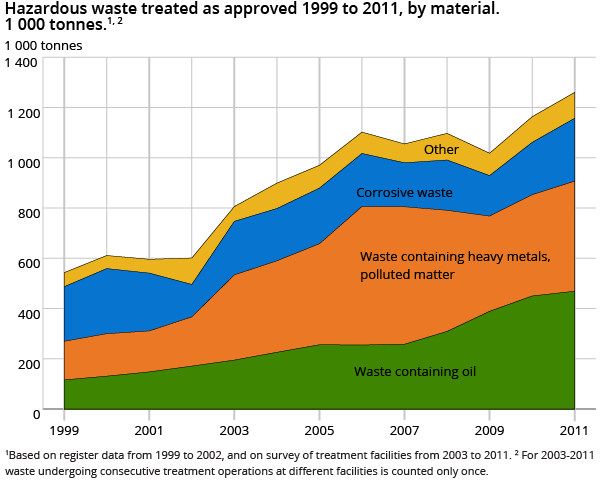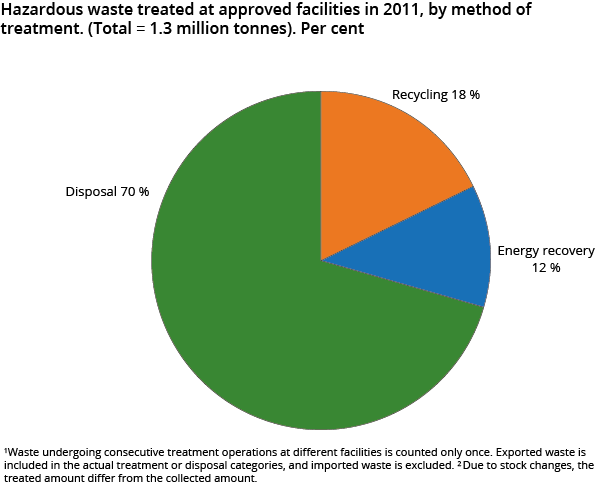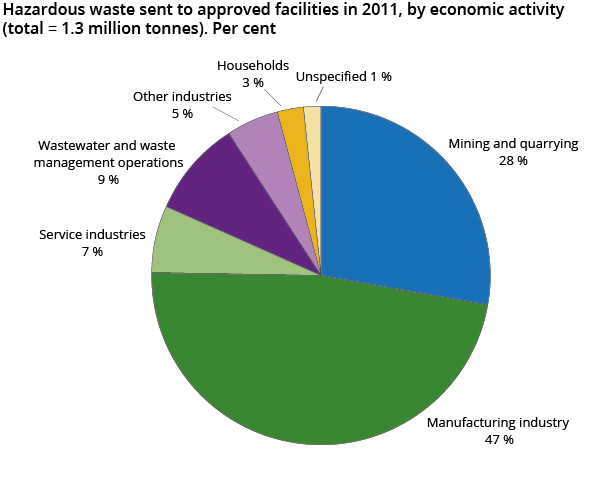Content
Published:
This is an archived release.
1.3 million tonnes of hazardous waste
A total of 1.3 million tonnes of hazardous waste were sent for approved treatment in 2011; up 8 per cent from the previous year. Since the statistics started in 1999, the amount of hazardous waste has increased by 132 per cent.
| 2011 | 2010 | 2007 | Change in per cent | ||
|---|---|---|---|---|---|
| 2010 - 2011 | 2007 - 2011 | ||||
| Total | 1 260 | 1 162 | 1 056 | 8.4 | 19.3 |
| Waste containing oil | 469 | 450 | 258 | 4.2 | 81.8 |
| Waste containing solvents | 21 | 28 | 19 | -25.0 | 10.5 |
| Other organic waste | 43 | 36 | 14 | 19.4 | 207.1 |
| Waste containing heavy metals, polluted matter | 438 | 403 | 547 | 8.7 | -19.9 |
| Corrosive waste | 250 | 208 | 175 | 20.2 | 42.9 |
| Other inorganic hazardous wastes | 7 | 7 | 14 | 0.0 | -50.0 |
| Processing water | 30 | 27 | 14 | 11.1 | 114.3 |
| Photo chemicals | 1 | 1 | 1 | 0.0 | 0.0 |
| Nonclassified hazardous waste | 1 | 3 | 13 | -66.7 | -92.3 |
Improved collection and reporting are assumed to be the main reasons for this increase. Furthermore, some waste types have been reclassified as hazardous throughout the period. It is a political goal that as much as possible of the hazardous waste will be given proper treatment in order to avoid harming people and the environment.
Oil and heavy metal-containing waste dominates
Oil-containing waste – total of 470 000 tonnes - makes up the largest fraction of hazardous waste in 2011. This included, but was not limited to, waste from oil drilling activities at sea. The second largest is heavy metal-containing waste, totalling 440 000 tonnes. The majority of this was slag from manufacturing, but also impregnated wood, batteries and used sand from grit blasting.
94 per cent to approved treatment
The statistics provide figures for the amounts of hazardous waste sent for both approved and unknown treatment. Unknown treatment means that the waste has not been properly registered by an authorised facility, and for 2011 this amount totalled 76 000 tonnes. In connection with the 1.3 million tonnes receiving approved treatment, this means that 94 per cent of hazardous waste was treated at approved facilities, according to estimations. This is around the same level as the year before.
Around 30 per cent of the waste treated as approved was recycled, i.e. material or energy recovery. The remaining 70 per cent was disposed of, mainly stabilised through chemical or physical pre-treatment and stored at specially-designed landfills. Treatment abroad is included in these figures, but stock changes are not.
More transboundary shipments of hazardous waste
Norway received 390 000 tonnes of hazardous waste from foreign countries in 2011, up 3.5 per cent from the previous year. Simultaneously, the exported amount increased by 4 per cent to 180 000 tonnes. Imports are dominated by waste containing heavy metals and polluted mineral matter destined for landfilling in Norway. Exports, on the other side, are mainly heavy metal-containing waste, process water and various types of oil-containing hazardous waste.
The import and export of hazardous waste requires approval from the authorities in order to ensure proper treatment in the receiving country.
600 000 from manufacturing
Manufacturing industries sent 600 000 tonnes of hazardous waste to approved treatment in 2011, including treatment in their own facilities. This makes up almost half of all hazardous waste in Norway. Another main contributor - with almost 350 000 tonnes - is mining and quarrying, which includes oil extraction.
The pronounced increase in hazardous waste for sewerage, waste management and remediation activities compared to earlier years is due to certain parties exporting waste out of the country. It is somewhat uncertain whether all of this waste is generated by this sector alone.
Households accounted for around 32 000 tonnes of hazardous waste sent to approved treatment in 2011; an increase of 2 000 tonnes compared to the year before. Impregnated wood, paint residues and waste oil constitute the main components.
More hazardous waste from Svalbard
About 100 to 300 tonnes of hazardous waste is shipped to the mainland each year, but the exact amount varies. In 2010, the amount was 330 tonnes, of which almost 90 per cent was made up from oil-containing waste. Hazardous waste from Svalbard is transported to the mainland for treatment there.
Approved and unknown treatmentOpen and readClose
Approved treatment is defined in this context as treatment at a facility that has been approved by the authorities. It is assumed here that treatment is carried out in accordance with the permit, even if controls have illustrated that shortcomings may occur.
Hazardous waste to unknown treatment may or may not be handled legally. Thus, it is desirable to reduce this category to a low minimum, preferable zero. This can be done by gathering as much as possible of the information about treatment of hazardous waste in Norway today, and thus minimize the uncertainty of whether the hazardous waste has undergone the “right” treatment, as expected.
Additional information
Approved treatment as applied in this article includes only hazardous waste generated in Norway (export is therefore included, while import is excluded).
Contact
-
Gisle Berge
E-mail: gisle.berge@ssb.no
tel.: (+47) 48 12 19 97
-
Terje Lorentzen Landsem
E-mail: terje.landsem@ssb.no
tel.: (+47) 98 84 31 39



